Disturbed microcirculation in the hands of patients with systemic sclerosis detected by fluorescence optical imaging: a pilot study
- PMID: 28482872
- PMCID: PMC5422953
- DOI: 10.1186/s13075-017-1300-6
Disturbed microcirculation in the hands of patients with systemic sclerosis detected by fluorescence optical imaging: a pilot study
Abstract
Background: Utilising fluorescence optical imaging (FOI), the distribution of an intravenously applied colouring agent indocyanine green (ICG) can be analysed with the potential to identify malperfusion by little to no tissue enhancement. Systemic sclerosis (SSc) is characterised by the presence of digital ulcers reflecting progressive vasculopathy. The objective was to investigate the potential of FOI in the detection of disturbed microcirculation in the hands and fingers of patients with SSc and to link FOI findings to clinical signs of ischemia such as digital ulcers and pitting scars.
Methods: In this cross-sectional study, 63 patients with SSc and 26 healthy subjects were examined. FOI was performed in all 89 individuals and compared to clinical data and capillaroscopic findings assembled for the SSc cohort.
Results: Healthy subjects showed initial ICG signals in their fingertips in 93.6%, SSc patients in 78.5% (limited SSc) and 43.2% (diffuse SSc). Moreover, in SSc patients, FOI findings were significantly associated with a late capillaroscopic pattern, disseminated SSc features, a diffuse SSc subtype, and the presence of digital ulcers or pitting scars. Intra- and inter-reader reliability for FOI amounted to κ = 0.786 and κ = 0.834, respectively.
Conclusions: FOI is able to detect areas of reduced microcirculation in patients with SSc with high association to capillaroscopic findings. The results pave the way for future FOI investigations into its role in the prediction of complications due to an impaired acral perfusion.
Keywords: Digital ulcers; Disturbed microcirculation; Fluorescence optical imaging; Nailfold capillaroscopy; Raynaud’s phenomenon; Systemic sclerosis.
Figures
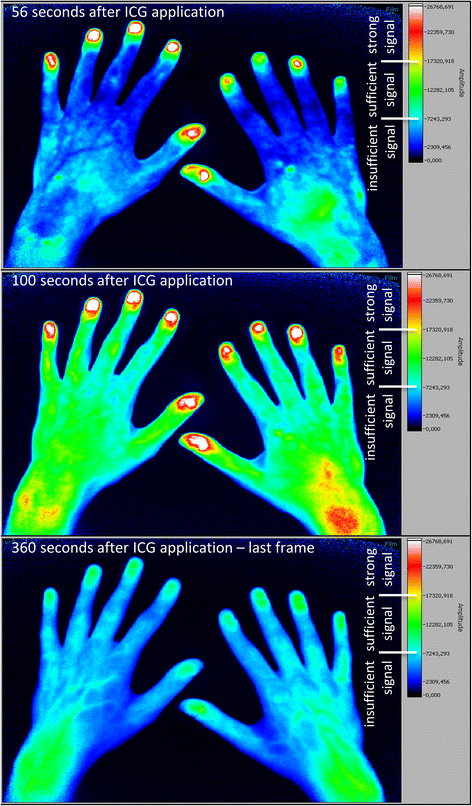
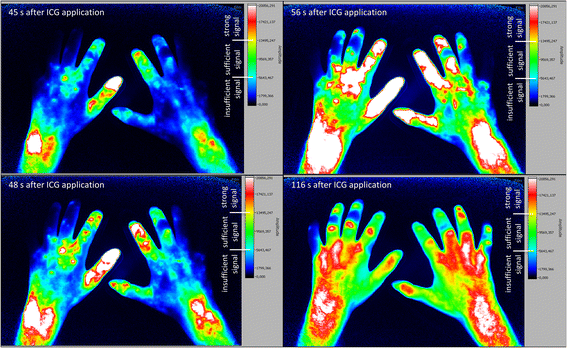
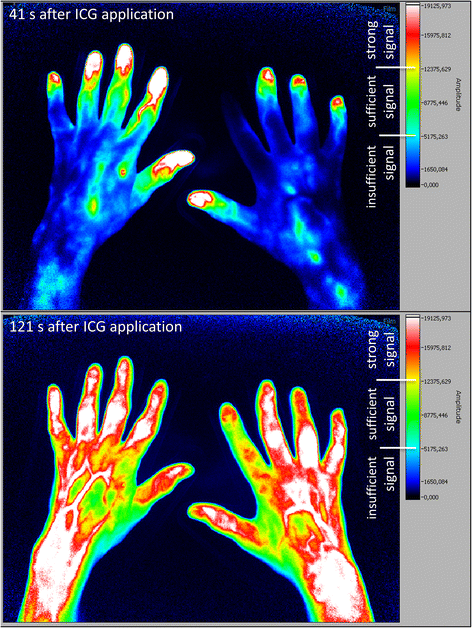
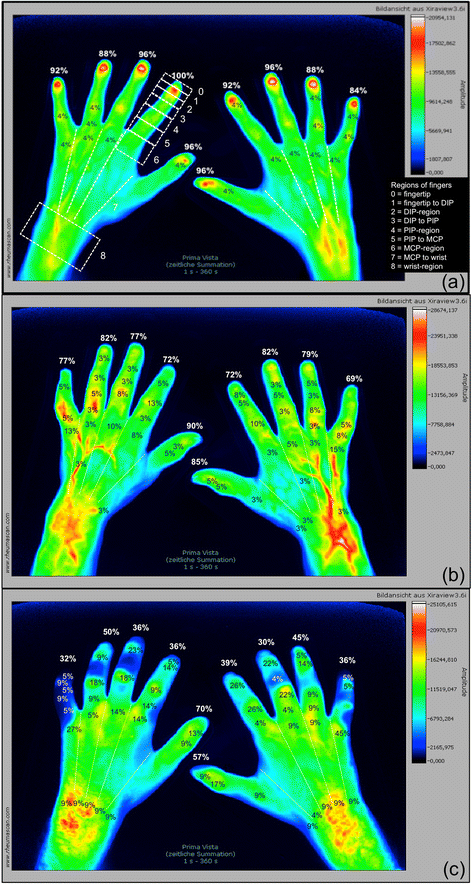
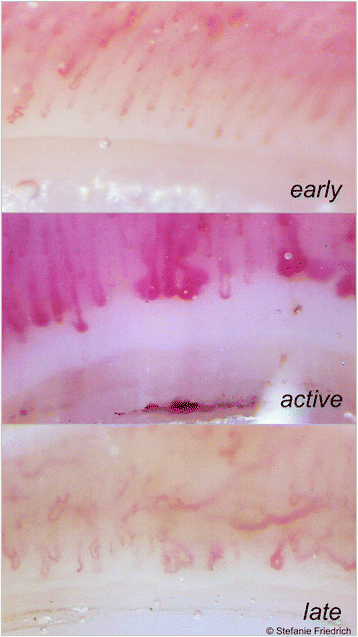
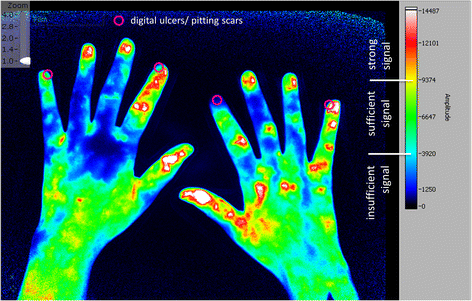
Similar articles
-
Association between baseline clinical and imaging findings and the development of digital ulcers in patients with systemic sclerosis.Arthritis Res Ther. 2019 Apr 15;21(1):96. doi: 10.1186/s13075-019-1875-1. Arthritis Res Ther. 2019. PMID: 30987674 Free PMC article.
-
The first composite score predicting Digital Ulcers in systemic sclerosis patients using Clinical data, Imaging and Patient history-CIP-DUS.Arthritis Res Ther. 2020 Jun 15;22(1):144. doi: 10.1186/s13075-020-02235-7. Arthritis Res Ther. 2020. PMID: 32539806 Free PMC article.
-
Comparison of laser Doppler imaging, fingertip lacticemy test, and nailfold capillaroscopy for assessment of digital microcirculation in systemic sclerosis.Arthritis Res Ther. 2010;12(4):R157. doi: 10.1186/ar3112. Epub 2010 Aug 10. Arthritis Res Ther. 2010. PMID: 20696074 Free PMC article. Clinical Trial.
-
Nailfold Capillaroscopy and Clinical Applications in Systemic Sclerosis.Microcirculation. 2016 Jul;23(5):364-72. doi: 10.1111/micc.12281. Microcirculation. 2016. PMID: 27086648 Review.
-
Measuring microangiopathy abnormalities in systemic sclerosis patients: the role of capillaroscopy-based scoring models.Am J Med Sci. 2014 Oct;348(4):331-6. doi: 10.1097/MAJ.0000000000000282. Am J Med Sci. 2014. PMID: 24853818 Review.
Cited by
-
Cardiovascular optoacoustics: From mice to men - A review.Photoacoustics. 2019 Mar 29;14:19-30. doi: 10.1016/j.pacs.2019.03.001. eCollection 2019 Jun. Photoacoustics. 2019. PMID: 31024796 Free PMC article. Review.
-
[Can rheuma be scanned? : Review of the current study situation on fluorescence optical imaging].Z Rheumatol. 2023 Oct;82(8):627-637. doi: 10.1007/s00393-023-01404-8. Epub 2023 Aug 25. Z Rheumatol. 2023. PMID: 37626223 Review. German.
-
Botulinum Toxin for the Treatment of Raynaud's Conditions of the Hand: Clinical Practice Updates and Future Directions.Toxins (Basel). 2024 Nov 1;16(11):472. doi: 10.3390/toxins16110472. Toxins (Basel). 2024. PMID: 39591227 Free PMC article. Review.
-
Metabolic and molecular imaging in inflammatory arthritis.RMD Open. 2024 Feb 9;10(1):e003880. doi: 10.1136/rmdopen-2023-003880. RMD Open. 2024. PMID: 38341194 Free PMC article. Review.
-
Association between baseline clinical and imaging findings and the development of digital ulcers in patients with systemic sclerosis.Arthritis Res Ther. 2019 Apr 15;21(1):96. doi: 10.1186/s13075-019-1875-1. Arthritis Res Ther. 2019. PMID: 30987674 Free PMC article.
References
-
- Glimm AM, Werner SG, Burmester GR, et al. Analysis of distribution and severity of inflammation in patients with osteoarthitis compared to rheumatoid arthritis by ICG-enhanced fluorescence optical imaging and musculoskeletal ultrasound: a pilot study. Ann Rheum Dis. 2016;75(3):566–70. doi:10.1136/annrheumdis-2015-207345. - PMC - PubMed
Publication types
MeSH terms
LinkOut - more resources
Full Text Sources
Other Literature Sources
Medical

